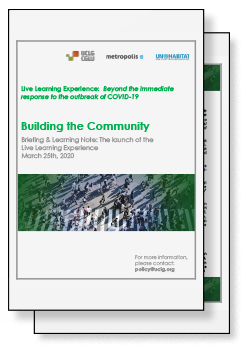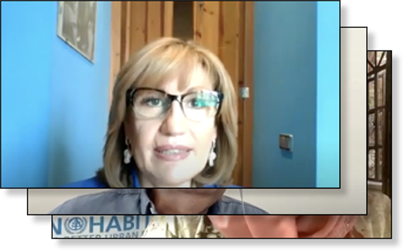Migration and youth
COVID-19 Response and Recovery for Migrant and Displaced Children and Youth, convened in partnership with UNICEF’s Child Friendly Cities initiative



Thembisile Nkadimeng
Mayor of Polokwane and UCLG Co-President

Shipra Narang
Chief of Urban Practices at UN-Habitat

Laura Healy
Policy and Advocacy Specialist of UNICEF

Ahmed Karimi
Youth delegate from United Nations Major Group for Children and Youth (UNMGCY)

Emilia Saiz
Secretary-General of UCLG




Background
The Covid-19 crisis impacted all layers of society, and specifically certain groups of the population such as youth and migrants, as estimated by the OECD. Youth are 2,5 times more likely to be unemployed than older people, and less than half of them trust their governments worldwide. Even though they are less exposed to health precariousness, educational and work deprivation put them in situations of vulnerability.
According to data presented by the UN and UNICEF[1], an important share of the overall migrant population is composed of young people (from 15 to 24 years old) and children (any person under the age of 18). Indeed, 15% of the total migrant stock in 2020 were children and 12% were youth, with an increase of about 1,5% compared to the previous year. The number of isolated minors on the move has been increasing in the past years, which further threatens their inclusion, their safety and their capacity to fulfill their aspirations.
In the wake of Covid-19, migrant populations have witnessed their life conditions worsened. Among such unprecedented challenges, OECD[2] evidenced restricted access to any healthcare system, increasingly difficult social distancing, and more racist attacks than usual. Moreover, the migrant population is much more exposed to contamination, with 95% of the confirmed cases in Singapore related to migrants’ dormitories[3]. Likewise, among the 20 countries with the highest number of cases, at least 7 countries depend on foreign-born workers in healthcare services.
This experience took place in the form of a dialogue between mayors and youth delegates about what local and regional governments can do – and are doing – to make sure that migrants, displaced children and their families are included in preparedness, response and recovery from the ongoing COVID-19 pandemic.
[1] https://migrationdataportal.org/themes/child-and-young-migrants
[2] https://ec.europa.eu/migrant-integration/news/covid-19s-impact-on-migrant-communities
[3] https://migrationdataportal.org/themes/migration-data-relevant-covid-19-pandemic
2,5
15%
Challenges
- Migrants’ absolute rights, especially for populations who have historically discriminated, must be ensured by local governments.
- Especially children and youth migrants must be protected from dangerous situations such as forced labour and street violence. Furthermore, child and youth migrants have a great potential to alleviate the prevalent generational gap concerning the use of technology and are better qualified to spread their knowledge amongst their families.
- Existing Connections and trust-building between municipalities and youth associations must be strengthened in order to allow participation of the people to contribute better to their cities and public spaces.
- In order to achieve social cohesion, migrants must be included amongst local populations. To this end, linguistic barriers, racist narratives need to be erased through education and communication strategies.
Responses
Local governments and institutions already cooperated in several parts of the world to ensure youth and migrants’ inclusion. For instance,
- Quito National Framework and REFELA Campaign protect children and youth rights both in Ecuador and South Africa. In Bamenda, the municipality enrolled migrant children back in school by subsidising their fees.
- Since knowledge is a cornerstone for empowerment, Tehran (Iran), in the wake of the UNICEF Child Friendly Cities Initiative (CFCI) became a pilot city in providing educational services to immigrant children.
- In order to respond to an urgent need for understanding, Oujda City (Maroc) created the MC2CM project to compile a comprehensive migrant database which allowed the municipality to efficiently identify key actors in migration governance activities, including migrant children and youth through a multi-stakeholder approach.
- The European Union, UNICEF and UNHCR united themselves to protect migrating children in Central America, Mexico and Southern Africa. The programme they set up aims to strengthen the capacity of the child protection system, to better detect children in suffering, and to document children’s movements in order to strengthen global cooperation.
Towards the Pact
- Children and migrant protection is essential to ensure that the cities of the future are peaceful and intercultural places. To achieve this, cultural mediation and data collection would be essential to foster fair communication and narratives.
- The public space must be open to voices that have been structurally discriminated against and subdued, but who have a role to play since they share the same territory.
- UCLG remains committed to driving this agenda forwards at the global level, counting on the support of UNICEF and partnerships like the Global Alliance Cities For Children, to help equip cities and regions in the world with the tools, resources and arguments they need to include, protect and empower every migrant and displaced child and young person.
- UCLG is advancing its child-sensitive agenda to showcase the critical role and work of local and regional governments championing the rights of migrant and displaced children and youth – listening to them, working with them and helping foster their potential.
- The event organisers UCLG, with Metropolis, UN habitat, ICMPD and UNICEF, and the UNMGCY, remain committed to further similar discussions and produce policy reflections and recommendations that the LRG membership – 250,000 local and regional governments around the world, can implement and collectively advocate for at the international level.
For further information on the topic of Public Service Delivery and its impact on cities and regions, please refer to the related resources included below.
- UCLG’s Live Learning Experience page
- Metropolis’ Cities for Global Health initiative
Frontliners
Thembisile Nkadimeng
Mayor of Polokwane and UCLG Co-President

Shipra Narang
Chief of Urban Practices at UN-Habitat

Laura Healy
Policy and Advocacy Specialist of UNICEF

Ahmed Karimi
Youth delegate from United Nations Major Group for Children and Youth (UNMGCY)

Emilia Saiz
Secretary-General of UCLG






